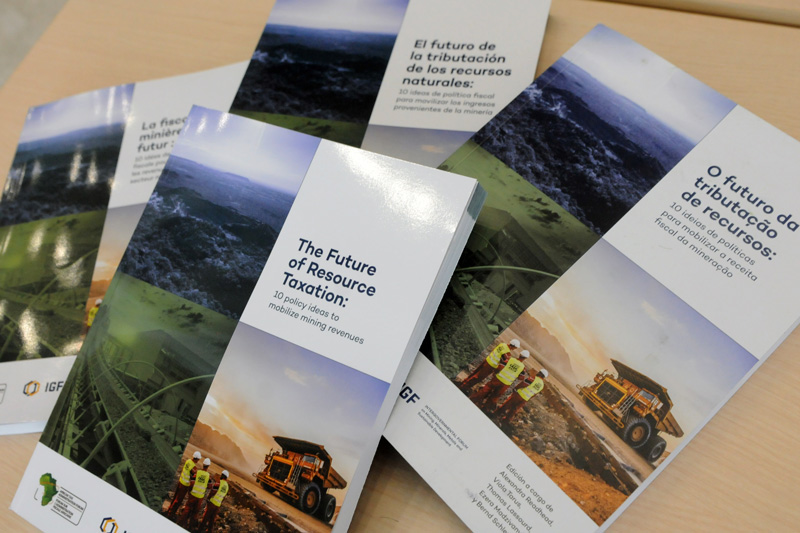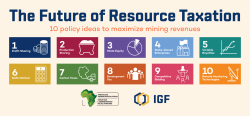As an international consensus around the energy transition pushes demand for more minerals, policy-makers are looking for new taxation, royalty, and other fiscal measures to ensure financial benefits from mining are shared equitably in the coming years.
Collecting revenue from mining often requires sector-specific knowledge and capacity to assess complex operations and cross-border transactions. These challenges can be especially costly for developing countries with limited expertise and administrative capacity. In Africa, countries lose an estimated USD 470 to 730 million in annual mining revenue from tax avoidance by multinational corporations.
Policy-makers recently gathered at the Global Conference on the Future of Resource Taxation. During the event, officials from disparate nations shared experiences about the difficulties of revenue collection in mining. For example, many expressed a need to reduce their reliance on corporate income tax, which is vulnerable to profit shifting—a practice whereby multinationals move profits from high-tax to low-tax jurisdictions via transactions between related parties. Mineral pricing is another widespread challenge for agencies tasked with assessing the true value of various mineral products for the purposes of revenue collection.
Highlights from the Global Conference on the Future of Resource Taxation
Government officials came to the global conference to learn about innovative policies offering simplicity, participation, fairness, and compensation for governments. These policy ideas are outlined in a new handbook for policy-makers launched at the conference, The Future of Resource Taxation: 10 Policy Ideas to Mobilize Mining Revenues, co-published by the IGF and the African Tax Administration Forum.
Simplicity
The handbook explores policies that can help governments streamline the process of determining the correct price and quantity of a mineral to compute corporate income tax. The Sixth Method, for example, used in Bolivia, Costa Rica, and Zambia, uses publicly quoted prices to calculate revenue from the sale of minerals. Such prices provide a clear and transparent standard for determining the price of related-party mineral sales that would be easier for tax authorities to apply and less vulnerable to tax avoidance.
Participation
Governments are keen to play a bigger role in extracting, processing, and selling mineral commodities to increase their financial benefits from mining. The potential demand for critical minerals has led some countries to consider creating state-owned enterprises in the mining sector. Mexico has established one for lithium; Chile has similar plans. Unfortunately, many such state enterprises have, in the past, failed to achieve their objectives and have often been plagued by poor governance. The handbook draws lessons from the design and governance of Chile’s national copper enterprise, as well as state-owned companies in Mongolia and Morocco. These lessons underscore, for example, the importance of an independent and professional advisory board steering these organizations in the right direction.
Fairness
A fair regime should collect more revenue when companies have the highest ability to pay and less in a more challenging economic context. A variable royalty, for example, has a rate that varies with some measure of mineral price or profitability. Countries such as Mongolia, Bolivia, and Zambia adjust their royalty based on mineral prices. This means that when the price of a mineral is high, the government should reap more benefits and vice versa. Variable royalties are self-adjusting, making the regime predictable to investors while helping governments improve mining revenue collection. Lastly, they are easy to communicate to the public; citizens like to see royalties increase with profits, especially if part of it is earmarked for communities.
Compensation
Benefits from the mining sector should flow to communities. This is especially true for those near mining operations who are highly likely to experience the negative effects of mining. While some jurisdictions, such as Papua New Guinea, have earmarked their royalty contributions for the local community, other countries lack legal obligations to compensate local communities. In the latter’s case, the handbook proposes introducing a “development turnover tax” levied on mining companies and earmarked for communities. Mining companies would have the option to invest directly to provide public benefits and receive an offset from the development turnover tax liability. Such a tax would benefit the community and contribute to the investor’s social licence to operate.
Solutions for a Tailored Approach
While our handbook for policy-makers considers each of the 10 ideas separately, no policy option can be viewed in isolation. A well-designed fiscal regime for mining considers all taxes and charges covering the mining sector as a package that fits each country’s unique stakeholders, circumstances, and priorities. Reforming longstanding practices is never easy, but these ideas show clear ways forward for governments working to ensure that mining fully benefits their country.


